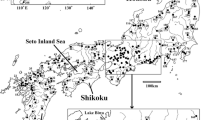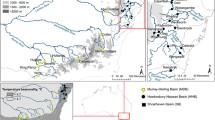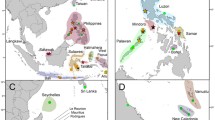Abstract.
We assayed the pattern of mitochondrial DNA evolution in the live bearing, seagrass specialist pipefish, Urocampus carinirostris, in eastern Australia. These life history attributes were predicted to result in strong phylogeographic structure in U. carinirostris. Phylogenetic analysis of cytochrome b sequences detected two monophyletic mtDNA clades that differed by 8.69% sequence divergence – a large level of intraspecific divergence for a marine fish. The geographical distribution of clades was non-random and resembled clinal secondary intergradation over a 130-km stretch of coastline. Contrary to phylogeographic predictions, this large phylogeographic break does not occur across a traditionally recognised biogeographic boundary. Analyses of historical demography suggested that individuals belonging to the most widespread clade underwent a population expansion from a small refuge population during the Pleistocene.
Similar content being viewed by others
Author information
Authors and Affiliations
Additional information
Electronic Publication
Rights and permissions
About this article
Cite this article
Chenoweth, .S., Hughes, .J. & Connolly, .R. Phylogeography of the pipefish, Urocampus carinirostris, suggests secondary intergradation of ancient lineages. Marine Biology 141, 541–547 (2002). https://doi.org/10.1007/s00227-002-0836-3
Received:
Accepted:
Issue Date:
DOI: https://doi.org/10.1007/s00227-002-0836-3




